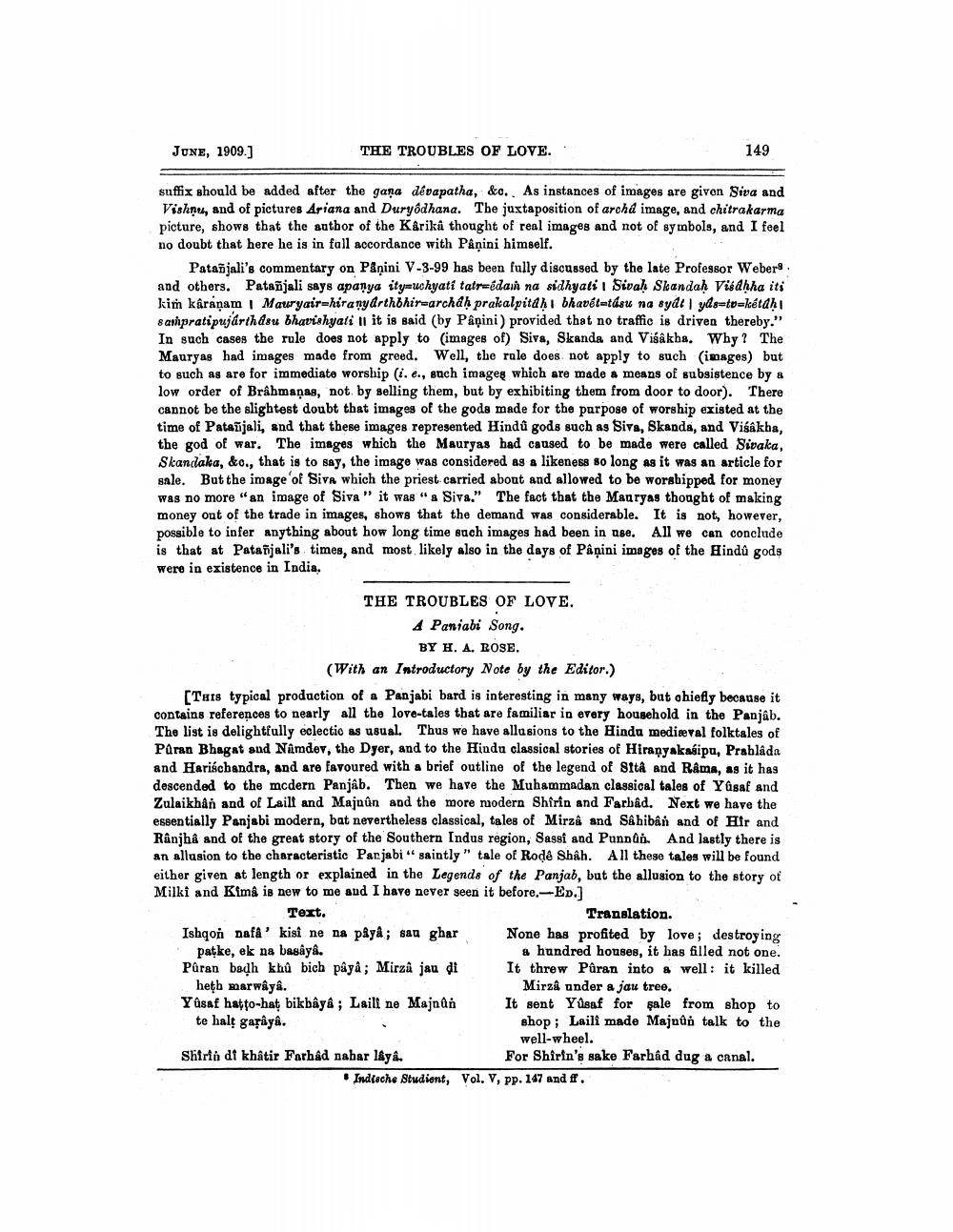________________
JUNE, 1909.]
THE TROUBLES OF LOVE.
suffix should be added after the gana dévapatha, &c. As instances of images are given Siva and Vishnu, and of pictures Ariana and Duryodhana. The juxtaposition of archd image, and chitrakarma picture, shows that the author of the Kârikâ thought of real images and not of symbols, and I feel no doubt that here he is in full accordance with Pânini himself.
Patanjali's commentary on Panini V-3-99 has been fully discussed by the late Professor Webers and others. Patanjali says apanya ity-uchyati tatr-édam na sidhyati | Sivaḥ Skandaḥ Visdhha iti kim karanam | Mauryair-hiranyarthbhir-archaḥ prakalpitaḥ bhavél-tásu na syat | yds=tv=kétaḥ sampratipujárthasu bhavishyati II it is said (by Pânini) provided that no traffic is driven thereby." In such cases the rule does not apply to (images of) Siva, Skanda and Visâkha. Why? The Mauryas had images made from greed. Well, the rule does not apply to such (images) but to such as are for immediate worship (i. e., such images which are made a means of subsistence by a low order of Brahmaṇas, not by selling them, but by exhibiting them from door to door). There cannot be the slightest doubt that images of the gods made for the purpose of worship existed at the time of Patanjali, and that these images represented Hindû gods such as Siva, Skanda, and Visakha, the god of war. The images which the Mauryas had caused to be made were called Sivaka, Skandaka, &c., that is to say, the image was considered as a likeness so long as it was an article for sale. But the image of Siva which the priest carried about and allowed to be worshipped for money was no more "an image of Siva" it was "a Siva." The fact that the Mauryas thought of making money out of the trade in images, shows that the demand was considerable. It is not, however, possible to infer anything about how long time such images had been in use. All we can conclude is that at Patanjali's times, and most likely also in the days of Pânini images of the Hindu gods were in existence in India,
THE TROUBLES OF LOVE.
A Panjabi Song.
BY H. A. ROSE.
(With an Introductory Note by the Editor.)
149
[THIS typical production of a Panjabi bard is interesting in many ways, but chiefly because it contains references to nearly all the love-tales that are familiar in every household in the Panjab. The list is delightfully eclectic as usual. Thus we have allusions to the Hindu medieval folktales of Puran Bhagat and Namdev, the Dyer, and to the Hindu classical stories of Hiranyakasipu, Prablâda and Harischandra, and are favoured with a brief outline of the legend of Sita and Rama, as it has descended to the mcdern Panjab. Then we have the Muhammadan classical tales of Yusaf and Zulaikhan and of Laill and Majuûn and the more modern Shîrîn and Farbâd. Next we have the essentially Panjabi modern, bat nevertheless classical, tales of Mirza and Sahibân and of Hir and Ranjha and of the great story of the Southern Indus region, Sassi and Punnûn. And lastly there is an allusion to the characteristic Panjabi " saintly" tale of Rodê Shah. All these tales will be found either given at length or explained in the Legends of the Panjab, but the allusion to the story of Milki and Kimâ is new to me and I have never seen it before.-ED.]
Text. Ishqon nafâ' kisi ne na pâyâ; sau ghar patke, ek na basâyâ.
Puran badh khû bich pâyâ; Mirzâ jau di heth marwâyâ.
Yusaf hatto-hat bikhâyâ; Laill ne Majnun te halt gaṛâyâ.
Shirin di khâtir Farhad nahar lâyâ.
Translation.
None has profited by love; destroying a hundred houses, it has filled not one. It threw Pûran into a well: it killed Mirza under a jau tree.
It sent Yusaf for sale from shop to shop; Laili made Majnûn talk to the well-wheel.
For Shirin's sake Farhâd dug a canal.
• Indische Studient, Vol. V, pp. 147 and ff.




